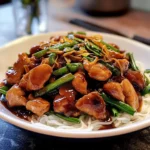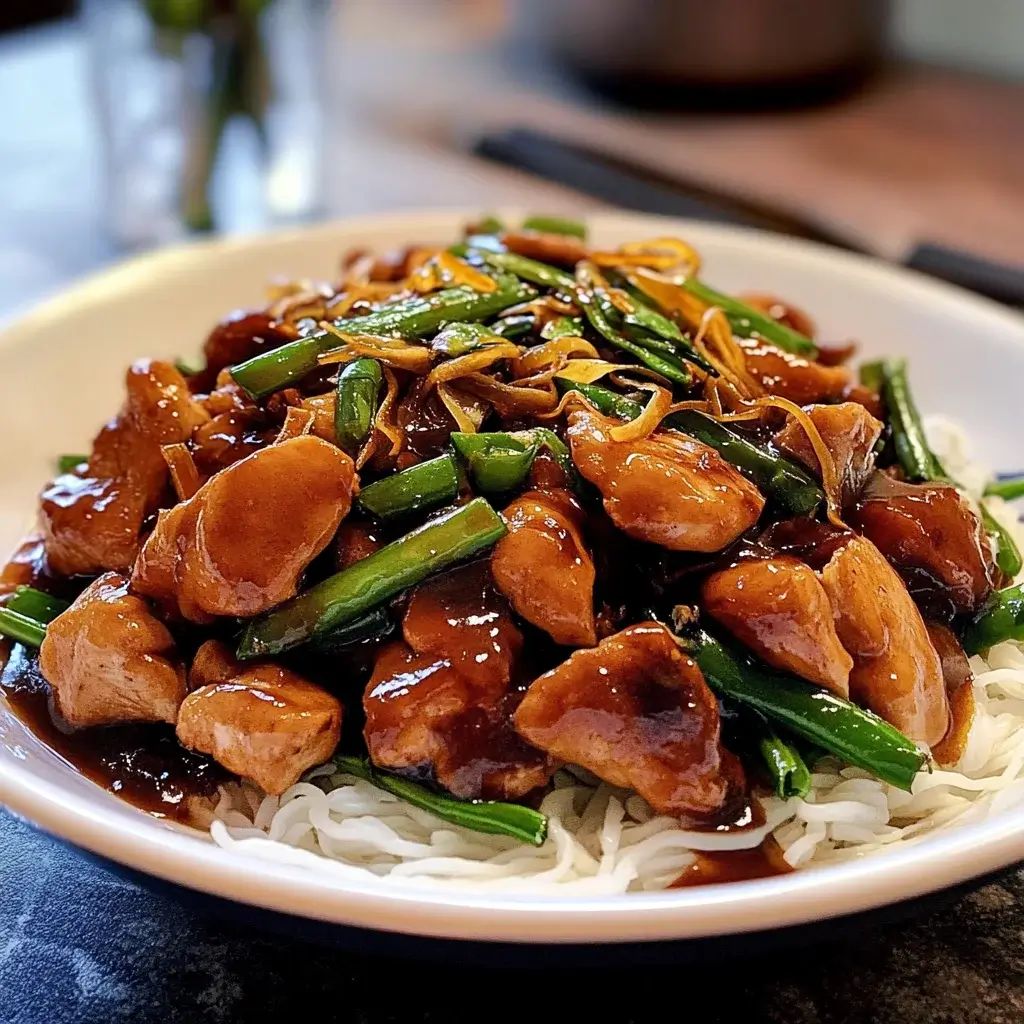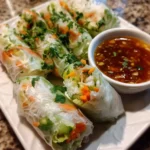There are some weeknights when the thought of cooking feels like scaling a mountain. You’re tired, everyone’s hungry, and the siren song of takeout is almost deafening. It was on one such evening, staring into the fridge with a distinct lack of inspiration, that this Ginger Soy Chicken Stir Fry recipe truly became a hero in my kitchen. I needed something fast, something packed with flavor, and something relatively healthy that wouldn’t leave us feeling sluggish. Skeptical glances from my family turned into murmurs of appreciation as the kitchen filled with the incredible aroma of sizzling ginger, garlic, and soy sauce. The chicken was perfectly tender, the vegetables vibrant and crisp-tender, and the sauce – oh, that glorious sauce – coated everything in a savory, slightly sweet, umami-rich glaze with just the right kick of ginger. Since that first successful rescue mission, this stir fry has become a regular in our rotation. It’s customizable, incredibly quick once you get the prep down, and consistently delivers that satisfying, better-than-takeout experience my whole family now requests. It’s proof that delicious, vibrant meals don’t always require hours of effort, just a little bit of prep and a seriously good sauce.
Ingredients
Here’s what you’ll need to create this vibrant and flavorful Ginger Soy Chicken Stir Fry:
For the Chicken & Marinade:
- 1.5 lbs (about 680g) Boneless, Skinless Chicken: Thighs are recommended for extra flavor and moisture, but breasts work well too. Slice thinly against the grain.
- 1 Tablespoon Low-Sodium Soy Sauce: Forms the salty, umami base of the marinade. Use low-sodium to better control the final dish’s saltiness.
- 1 Tablespoon Cornstarch: Helps to create a velvety texture on the chicken and protects it from overcooking, ensuring tenderness.
- 1 Teaspoon Sesame Oil: Adds a hint of nutty aroma to the chicken itself.
For the Ginger Soy Stir-Fry Sauce:
- 1/2 Cup (120ml) Low-Sodium Soy Sauce: The primary flavor driver, providing savory depth.
- 1/4 Cup (60ml) Water or Low-Sodium Chicken Broth: Adds volume to the sauce without overpowering other flavors; broth adds a little more richness.
- 2 Tablespoons Honey or Maple Syrup: Provides balance to the savory soy sauce with a touch of sweetness. Adjust to your preference. Brown sugar can also be substituted.
- 2 Tablespoons Rice Vinegar: Adds a necessary tang and brightness to cut through the richness. Apple cider vinegar can work in a pinch.
- 1 Tablespoon Cornstarch: The thickening agent for the sauce, creating that perfect glossy coating.
- 1 Tablespoon Freshly Grated Ginger: Absolutely essential for the signature flavor. Use a microplane or fine grater for best results (about a 1-inch piece).
- 3-4 Cloves Garlic, Minced: Provides aromatic depth and pungency. Don’t skimp here!
- 1 Teaspoon Toasted Sesame Oil: Added at the end for its distinct nutty fragrance and flavor; toasting enhances this.
For the Stir-Fry:
- 2 Tablespoons High-Heat Cooking Oil: Such as avocado, grapeseed, canola, or peanut oil, divided. Needed for sautéing without burning.
- 1 Large Onion (Yellow or Red): Sliced or cut into wedges, providing a foundational aromatic flavor.
- 1 Red Bell Pepper: Seeded and sliced, adding sweetness and vibrant color.
- 1 Green Bell Pepper: Seeded and sliced, offering a slightly more vegetal flavor and contrasting color.
- 1 Large Carrot: Peeled and thinly sliced on the diagonal (or julienned), for sweetness and crunch.
- 1 Head of Broccoli: Cut into small florets (about 2 cups), adding essential greens and texture.
- 4 Ounces (about 115g) Snow Peas or Sugar Snap Peas: Trimmed, providing a lovely crispness and fresh flavor.
Optional Garnishes:
- Sliced Green Onions: For a fresh, pungent finish.
- Toasted Sesame Seeds: For texture and nutty flavor.
- Red Pepper Flakes: For those who like a little heat.
Instructions
Follow these steps carefully for a perfectly executed Ginger Soy Chicken Stir Fry:
- Marinate the Chicken: In a medium bowl, combine the thinly sliced chicken, 1 tablespoon of low-sodium soy sauce, 1 tablespoon of cornstarch, and 1 teaspoon of sesame oil. Toss well to ensure every piece of chicken is coated. Set aside to marinate for at least 15 minutes at room temperature (or up to 30 minutes in the refrigerator). This step, known as velveting, helps keep the chicken tender and flavorful.
- Prepare the Stir-Fry Sauce: In a separate small bowl or liquid measuring cup, whisk together all the sauce ingredients: 1/2 cup low-sodium soy sauce, 1/4 cup water or broth, 2 tablespoons honey/maple syrup, 2 tablespoons rice vinegar, 1 tablespoon cornstarch, 1 tablespoon grated ginger, minced garlic, and 1 teaspoon toasted sesame oil. Ensure the cornstarch is fully dissolved to prevent lumps. Set aside.
- Prepare the Vegetables (Mise en Place): Wash, chop, and slice all your vegetables as described in the ingredients list. Stir-frying happens quickly, so having everything prepped and ready near your stovetop is crucial. Group vegetables by cooking time – harder vegetables like carrots and broccoli florets will go in first, followed by quicker-cooking ones like bell peppers, onions, and snow peas.
- Heat the Wok or Pan: Place a large wok or heavy-bottomed skillet over high heat. Allow it to get smoking hot – this is key for achieving the characteristic stir-fry char and preventing sticking. Add 1 tablespoon of your high-heat cooking oil and swirl to coat the bottom.
- Cook the Chicken: Once the oil shimmers, carefully add the marinated chicken in a single layer. You may need to do this in two batches to avoid overcrowding the pan, which lowers the temperature and causes the chicken to steam rather than sear. Stir-fry for 3-5 minutes per batch, tossing occasionally, until the chicken is golden brown and cooked through. Remove the cooked chicken from the pan with a slotted spoon and set aside on a clean plate.
- Stir-Fry Aromatics and Harder Vegetables: Add the remaining 1 tablespoon of oil to the hot wok/skillet. Add the sliced onion and stir-fry for 1-2 minutes until it starts to soften and become fragrant. Add the carrots and broccoli florets. Stir-fry for 3-4 minutes, tossing frequently, until they are vibrant and begin to become tender-crisp. You can add a tablespoon or two of water if the pan seems too dry or if you prefer softer vegetables, covering briefly to steam.
- Add Softer Vegetables: Add the sliced bell peppers and snow peas (or sugar snap peas) to the wok. Continue to stir-fry for another 2-3 minutes. You want the vegetables to retain some bite and their bright color.
- Combine and Sauce: Return the cooked chicken to the wok with the vegetables. Give the prepared stir-fry sauce a quick whisk (as the cornstarch may have settled) and pour it evenly over the chicken and vegetables.
- Thicken the Sauce: Bring the mixture to a simmer, stirring constantly. The sauce will begin to bubble and thicken quite quickly due to the cornstarch, usually within 1-2 minutes. Cook until the sauce coats the chicken and vegetables nicely and has reached your desired consistency (it should be glossy and thick enough to cling).
- Finish and Serve: Remove the wok from the heat. If desired, stir in a final drizzle of toasted sesame oil for extra aroma. Taste and adjust seasoning if necessary, although it should be well-balanced. Serve immediately over your choice of base. Garnish generously with sliced green onions and toasted sesame seeds, adding red pepper flakes if you like heat.
Nutrition Facts
- Servings: This recipe typically yields 4 generous servings.
- Calories Per Serving: Approximately 450-550 kcal (This is an estimate and can vary based on exact ingredients used, particularly the cut of chicken and amount of oil/sweetener).
- Protein: High (Approx. 35-45g) – Primarily from the chicken, essential for muscle repair and satiety.
- Fiber: Moderate (Approx. 5-8g) – Contributed by the variety of vegetables like broccoli, carrots, and peppers, supporting digestive health.
- Sodium: Moderate to High (Approx. 900-1200mg) – Mainly from the soy sauce. Using low-sodium soy sauce helps manage this, but it remains a significant source. Be mindful if on a sodium-restricted diet.
- Sugar: Moderate (Approx. 10-15g) – Primarily from the honey/maple syrup used for balancing the sauce. Natural sugars also present in vegetables.
- Fat: Moderate (Approx. 15-25g) – Comes from the cooking oil, sesame oil, and chicken (especially if using thighs). Includes healthier unsaturated fats depending on the oil choice.
(Disclaimer: Nutritional information is estimated and can vary widely based on specific ingredients, brands, portion sizes, and cooking methods used. Consult a registered dietitian or use a nutritional analysis tool for precise figures.)
Preparation Time
- Prep Time: Approximately 20-25 minutes. This includes slicing the chicken, chopping all the vegetables, and whisking together the sauce. Efficient knife skills and organization (mise en place) can speed this up.
- Marinating Time: 15 minutes (at minimum).
- Cook Time: Approximately 15-20 minutes. Stir-frying itself is very fast once the pan is hot.
- Total Time: Approximately 50-60 minutes from start to finish, including marinating time. This makes it a feasible and highly rewarding weeknight meal option despite the initial chopping involved.
How to Serve
This Ginger Soy Chicken Stir Fry is wonderfully versatile. Here are some classic and creative ways to serve it:
- Classic Rice Base:
- Steamed Jasmine Rice: The fragrant aroma and slightly sticky texture perfectly complement the savory sauce.
- Steamed Brown Rice: A healthier, whole-grain option with a nuttier flavor and chewier texture.
- Coconut Rice: Cooking rice with coconut milk adds a subtle sweetness and richness that pairs beautifully.
- Noodle Options:
- Egg Noodles: Toss the finished stir fry directly with cooked Chinese egg noodles for a lo mein style dish.
- Udon Noodles: Thick, chewy Japanese wheat noodles provide a satisfying bite.
- Rice Noodles: Thin or wide rice noodles offer a gluten-free alternative.
- Low-Carb Bases:
- Cauliflower Rice: A popular low-carb and grain-free option that readily absorbs the sauce.
- Zucchini Noodles (Zoodles): Light and healthy, adds extra veggies. Best served immediately as they can release water.
- Quinoa: A protein-packed, gluten-free pseudo-grain with a slightly earthy flavor.
- Lettuce Wraps:
- Serve the stir fry mixture in crisp lettuce cups (like butter lettuce or iceberg) for a lighter, interactive meal.
- Enhancements and Garnishes:
- Mandatory: Sliced green onions (scallions) and toasted sesame seeds are highly recommended for freshness and texture.
- Optional Heat: A sprinkle of red pepper flakes or a drizzle of sriracha/chili garlic sauce.
- Extra Crunch: Toasted cashews or peanuts scattered over the top.
- Fresh Herbs: Chopped fresh cilantro can add another layer of brightness.
- Side Dishes:
- Keep it simple! A light Asian-style cucumber salad, steamed edamame, or crispy spring rolls work well alongside.
Additional Tips for the Perfect Ginger Soy Chicken Stir Fry
- Master Mise en Place: Stir-frying is incredibly fast. Have everything chopped, measured, and ready by the stove before you turn on the heat. This includes the chicken marinated, sauce whisked, veggies cut, and garnishes prepped. Trying to chop while things are cooking is a recipe for burnt food.
- High Heat is Non-Negotiable: A screaming hot wok or skillet is essential for achieving that signature “wok hei” (breath of the wok) flavor and ensuring vegetables are crisp-tender, not soggy. Let your pan heat up properly before adding oil. The oil should shimmer, or a drop of water should evaporate instantly.
- Don’t Crowd the Pan: This is a common stir-fry mistake. Adding too much food at once drastically lowers the pan temperature, leading to steaming instead of searing. Cook the chicken in batches if necessary, and ensure vegetables have room to make contact with the hot surface.
- Slice Chicken Thinly & Against the Grain: This ensures maximum tenderness and quick cooking. Slicing against the grain shortens the muscle fibers, making the meat less chewy. Slightly freezing the chicken for 15-20 minutes can make it much easier to slice thinly.
- Fresh Ginger and Garlic are Key: While dried versions exist, the pungent, bright flavor of freshly grated ginger and freshly minced garlic is crucial for this dish’s signature taste. Invest in a microplane grater for easy ginger prep.
- Control Vegetable Cooking Times: Add vegetables in stages based on their density. Start with harder ones like carrots and broccoli stems, then add medium-density ones like bell peppers and broccoli florets, and finish with delicate ones like snow peas or bean sprouts. Aim for tender-crisp, not mushy.
- Sauce Consistency Control: If your sauce seems too thin, mix an extra teaspoon of cornstarch with 2 teaspoons of cold water (a slurry) and stir it in while simmering until thickened. If it’s too thick, thin it with a tablespoon of water or broth at a time. Remember the sauce thickens quickly and will continue to thicken slightly off the heat.
- Taste and Adjust Before Serving: Always taste the final dish before plating. Does it need a tiny bit more saltiness (soy sauce)? More brightness (a squeeze of lime or dash of vinegar)? A touch more sweetness (honey)? A bit more heat (red pepper flakes)? Adjust accordingly to perfect the balance for your palate.
Frequently Asked Questions (FAQ) about Ginger Soy Chicken Stir Fry
- Can I use different vegetables in this stir fry?
Absolutely! Stir-fries are fantastic for using up whatever vegetables you have on hand. Good alternatives or additions include mushrooms (shiitake, cremini), zucchini, bok choy, baby corn, water chestnuts, celery, green beans, or asparagus. Just be mindful of cooking times and add them accordingly (harder veggies first, leafy greens last). - How can I make this recipe vegetarian or vegan?
Easily! Substitute the chicken with firm or extra-firm tofu (pressed and cubed), tempeh (cubed or sliced), or even chickpeas or edamame. For tofu or tempeh, consider pan-frying or baking it separately first until golden for better texture before adding it to the stir-fry near the end. Ensure your broth (if using) is vegetable broth, and swap honey for maple syrup or agave nectar for a fully vegan version. - Can I make this gluten-free?
Yes. The main source of gluten is typically the soy sauce. Simply substitute the regular soy sauce with certified gluten-free tamari or coconut aminos. Coconut aminos are slightly sweeter, so you might want to reduce the honey/maple syrup slightly. Ensure your cornstarch is certified gluten-free if Celiac disease is a concern, though most pure cornstarch is naturally gluten-free. - What’s the best way to store and reheat leftovers?
Store leftover stir fry in an airtight container in the refrigerator for up to 3-4 days. Reheat gently in a skillet over medium heat with a splash of water or broth to prevent drying out, or microwave in short bursts, stirring in between. Note that the vegetables will lose some of their crispness upon reheating. - Can I freeze this Ginger Soy Chicken Stir Fry?
While you can freeze it, it’s not ideal. The texture of the vegetables, especially softer ones like bell peppers and snow peas, can become mushy upon thawing and reheating. The sauce might also separate slightly. If you must freeze, cool it completely, store it in an airtight freezer-safe container for up to 2-3 months. Thaw overnight in the refrigerator before reheating. It’s generally better enjoyed fresh. - What is the best oil for stir-frying?
You need an oil with a high smoke point because stir-frying requires high heat. Excellent choices include avocado oil, peanut oil, grapeseed oil, canola oil, or sunflower oil. Avoid oils with low smoke points like extra virgin olive oil, which will burn and impart a bitter taste. Toasted sesame oil is used for flavor at the end, not for high-heat cooking. - My stir-fry sauce didn’t thicken properly. What went wrong?
There are a few possibilities: a) Not enough cornstarch was used, or it wasn’t measured correctly. b) The sauce wasn’t brought to a proper simmer – cornstarch needs heat to activate its thickening properties. c) You added too much extra liquid accidentally. To fix it, whisk 1-2 teaspoons of cornstarch with an equal amount of cold water to make a slurry. Stir this into the simmering sauce and continue to cook for another minute or two until it thickens. - Can I prepare parts of this dish ahead of time?
Yes, prepping ahead makes weeknight cooking much faster! You can:- Slice the chicken and marinate it up to 8 hours ahead (store covered in the fridge).
- Chop all the vegetables a day or two in advance and store them in airtight containers in the fridge (keep onions separate if possible to prevent their flavor from permeating other veggies).
- Whisk together the stir-fry sauce ingredients (except perhaps the final teaspoon of toasted sesame oil, add that just before using) and store it in a jar in the fridge for up to 3-4 days. Give it a good shake or whisk before using.

Ginger Soy Chicken Stir Fry
Ingredients
Here’s what you’ll need to create this vibrant and flavorful Ginger Soy Chicken Stir Fry:
For the Chicken & Marinade:
- 1.5 lbs (about 680g) Boneless, Skinless Chicken: Thighs are recommended for extra flavor and moisture, but breasts work well too. Slice thinly against the grain.
- 1 Tablespoon Low-Sodium Soy Sauce: Forms the salty, umami base of the marinade. Use low-sodium to better control the final dish’s saltiness.
- 1 Tablespoon Cornstarch: Helps to create a velvety texture on the chicken and protects it from overcooking, ensuring tenderness.
- 1 Teaspoon Sesame Oil: Adds a hint of nutty aroma to the chicken itself.
For the Ginger Soy Stir-Fry Sauce:
- 1/2 Cup (120ml) Low-Sodium Soy Sauce: The primary flavor driver, providing savory depth.
- 1/4 Cup (60ml) Water or Low-Sodium Chicken Broth: Adds volume to the sauce without overpowering other flavors; broth adds a little more richness.
- 2 Tablespoons Honey or Maple Syrup: Provides balance to the savory soy sauce with a touch of sweetness. Adjust to your preference. Brown sugar can also be substituted.
- 2 Tablespoons Rice Vinegar: Adds a necessary tang and brightness to cut through the richness. Apple cider vinegar can work in a pinch.
- 1 Tablespoon Cornstarch: The thickening agent for the sauce, creating that perfect glossy coating.
- 1 Tablespoon Freshly Grated Ginger: Absolutely essential for the signature flavor. Use a microplane or fine grater for best results (about a 1-inch piece).
- 3–4 Cloves Garlic, Minced: Provides aromatic depth and pungency. Don’t skimp here!
- 1 Teaspoon Toasted Sesame Oil: Added at the end for its distinct nutty fragrance and flavor; toasting enhances this.
For the Stir-Fry:
- 2 Tablespoons High-Heat Cooking Oil: Such as avocado, grapeseed, canola, or peanut oil, divided. Needed for sautéing without burning.
- 1 Large Onion (Yellow or Red): Sliced or cut into wedges, providing a foundational aromatic flavor.
- 1 Red Bell Pepper: Seeded and sliced, adding sweetness and vibrant color.
- 1 Green Bell Pepper: Seeded and sliced, offering a slightly more vegetal flavor and contrasting color.
- 1 Large Carrot: Peeled and thinly sliced on the diagonal (or julienned), for sweetness and crunch.
- 1 Head of Broccoli: Cut into small florets (about 2 cups), adding essential greens and texture.
- 4 Ounces (about 115g) Snow Peas or Sugar Snap Peas: Trimmed, providing a lovely crispness and fresh flavor.
Optional Garnishes:
- Sliced Green Onions: For a fresh, pungent finish.
- Toasted Sesame Seeds: For texture and nutty flavor.
- Red Pepper Flakes: For those who like a little heat.
Instructions
Follow these steps carefully for a perfectly executed Ginger Soy Chicken Stir Fry:
- Marinate the Chicken: In a medium bowl, combine the thinly sliced chicken, 1 tablespoon of low-sodium soy sauce, 1 tablespoon of cornstarch, and 1 teaspoon of sesame oil. Toss well to ensure every piece of chicken is coated. Set aside to marinate for at least 15 minutes at room temperature (or up to 30 minutes in the refrigerator). This step, known as velveting, helps keep the chicken tender and flavorful.
- Prepare the Stir-Fry Sauce: In a separate small bowl or liquid measuring cup, whisk together all the sauce ingredients: 1/2 cup low-sodium soy sauce, 1/4 cup water or broth, 2 tablespoons honey/maple syrup, 2 tablespoons rice vinegar, 1 tablespoon cornstarch, 1 tablespoon grated ginger, minced garlic, and 1 teaspoon toasted sesame oil. Ensure the cornstarch is fully dissolved to prevent lumps. Set aside.
- Prepare the Vegetables (Mise en Place): Wash, chop, and slice all your vegetables as described in the ingredients list. Stir-frying happens quickly, so having everything prepped and ready near your stovetop is crucial. Group vegetables by cooking time – harder vegetables like carrots and broccoli florets will go in first, followed by quicker-cooking ones like bell peppers, onions, and snow peas.
- Heat the Wok or Pan: Place a large wok or heavy-bottomed skillet over high heat. Allow it to get smoking hot – this is key for achieving the characteristic stir-fry char and preventing sticking. Add 1 tablespoon of your high-heat cooking oil and swirl to coat the bottom.
- Cook the Chicken: Once the oil shimmers, carefully add the marinated chicken in a single layer. You may need to do this in two batches to avoid overcrowding the pan, which lowers the temperature and causes the chicken to steam rather than sear. Stir-fry for 3-5 minutes per batch, tossing occasionally, until the chicken is golden brown and cooked through. Remove the cooked chicken from the pan with a slotted spoon and set aside on a clean plate.
- Stir-Fry Aromatics and Harder Vegetables: Add the remaining 1 tablespoon of oil to the hot wok/skillet. Add the sliced onion and stir-fry for 1-2 minutes until it starts to soften and become fragrant. Add the carrots and broccoli florets. Stir-fry for 3-4 minutes, tossing frequently, until they are vibrant and begin to become tender-crisp. You can add a tablespoon or two of water if the pan seems too dry or if you prefer softer vegetables, covering briefly to steam.
- Add Softer Vegetables: Add the sliced bell peppers and snow peas (or sugar snap peas) to the wok. Continue to stir-fry for another 2-3 minutes. You want the vegetables to retain some bite and their bright color.
- Combine and Sauce: Return the cooked chicken to the wok with the vegetables. Give the prepared stir-fry sauce a quick whisk (as the cornstarch may have settled) and pour it evenly over the chicken and vegetables.
- Thicken the Sauce: Bring the mixture to a simmer, stirring constantly. The sauce will begin to bubble and thicken quite quickly due to the cornstarch, usually within 1-2 minutes. Cook until the sauce coats the chicken and vegetables nicely and has reached your desired consistency (it should be glossy and thick enough to cling).
- Finish and Serve: Remove the wok from the heat. If desired, stir in a final drizzle of toasted sesame oil for extra aroma. Taste and adjust seasoning if necessary, although it should be well-balanced. Serve immediately over your choice of base. Garnish generously with sliced green onions and toasted sesame seeds, adding red pepper flakes if you like heat.
Nutrition
- Serving Size: one normal portion
- Calories: 550
- Sugar: 15g
- Sodium: 1200mg
- Fat: 25g
- Fiber: 8g
- Protein: 45g






